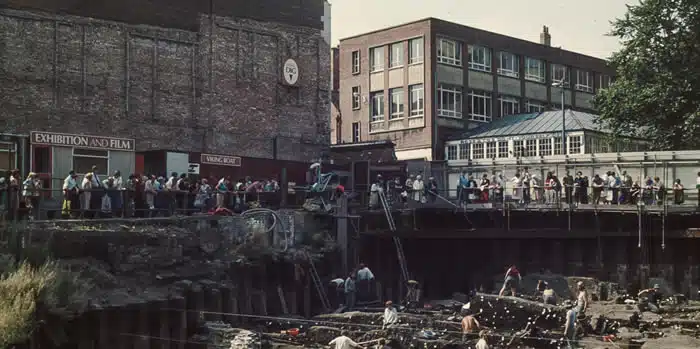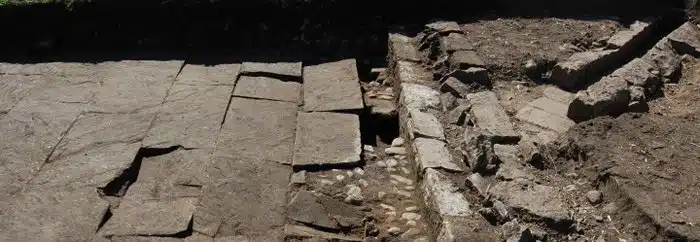“The extraordinary thing about York is that it’s like an enormous trifle – wherever you dig, you discover amazing layers of history. You can find the jelly of the Vikings, the sponge of the Middle Ages and the marashino cherry of the Romans!” – Actor and television presenter, Tony Robinson, Time Team Live 1999, Channel 4 Television.
 An archaeologist’s delight
An archaeologist’s delight
It’s no co-incidence that York was chosen to host a special live version of the popular BBC archaeology television programme Time Team in the autumn of 1999. The city is an archaeologist’s delight. York contains one of Britain’s very few ‘wet sites’, where organic materials such as wood and leather survive. And thanks to the combination of excellent preservative conditions and an extraordinarily rich and eventful history stretching back to the first century AD, archaeologists the world over recognise York as a treasure trove which has yielded many secrets but which still holds many more.
JORVIK
1,025 years ago the City of Jorvik (York as we know it today), bore witness to an unprecedented technological innovation. This was the ‘big bang’ of the Viking age. First great tracts of oak forests were felled, the timber was brought to York and from this a series of quite unique, and for their time highly sophisticated, high-rise buildings were created. These began to replace the crude wattle and daub huts of previous generations. How do we know this? In 1976 a team of archaeologists uncovered the substantial remains of those buildings, filled with earth, along with all the everyday rubbish of the townspeople, items such as broken combs (with head lice still between the teeth), socks, shoes, bees, flies and other insects. When this amazing dig was finished, the excavation was made into a cellar and over it a modern shopping centre was constructed (Coppergate). In the cellar was placed a life-sized recreation of part of the site, which became the Jorvik Viking Centre. JORVIK, as it is now known, is a renowned archaeological site in the city, and since the beginning of the dig in 1976, it has captured and sustained the public imagination. Over 15,000 objects were recovered in the process of uncovering a Viking city complete with workshops, rubbish pits, latrines and wells. The most spectacular find was an exquisitely preserved Anglo Saxon helmet, now on view in the Castle Museum. JORVIK provides a spectacular vision of exactly what it was like to be in this part of York in AD975 during this exciting year of change.
For more information on Jorvik, including opening times and prices, take a look at our things to do in York guide.
Layers of history
There is a whole mass of York’s heritage, buried – completely out of sight, sometimes as much as 5-6 metres deep, and representing nearly 2,000 years worth of human habitation; that’s buildings, defences, churches, cemeteries, streets and rubbish to you and I.
Take the Roman period. From AD71 there was a massive fortress housing 5,600 Roman soldiers. The Minster sits in the middle of the Roman fortress, but almost all traces of that huge defended area have now become buried beneath the muck of subsequent generations. Petergate, Stonegate and Chapter House Street (behind the Minster) were the main streets through the fortress, and indeed York’s most famous ghost is reputed to have been seen marching the line of Chapter House Street (the Via Decumana), up to his waist in cellar floor.
Roman Bath Public House
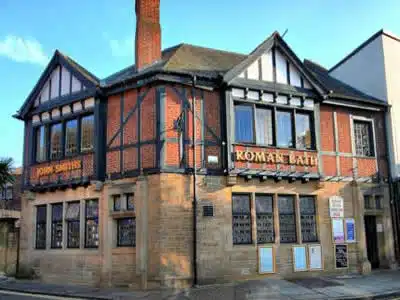
You can also visit officers’ houses (parts can be seen in the Undercroft of the Minster), the Legion’s headquarters building, also on view beneath York Minster, with a reconstructed column in Deangate giving an excellent idea of scale, even if reconstructed upside down!
As well as the below ground stuff there are also small bits from that era that still poke up into our lives, and you can see them today. The corner of the fortress defensive wall for example in Museum Gardens is still standing to an impressive height, and still as difficult to scale now as it was in the 4th century, or in the mid- ninth century, when the Vikings found that to take the City they were obliged to climb over it.
Where is the Viking archeology in York?
York is also very well known for its Vikings, and yet this period is even more poorly represented above ground! Apart from one late Viking-age church tower of St Mary Bishophill Junior, and some sculpture (also in churches, for example the north aisle of All Saint’s Pavement) one is forced to look to the work of archaeologists to discover York’s Vikings.
It is testimony to the amount of muck that our forefathers left strewn about that to reach Viking levels at the Jorvik Viking Centre, one has to descend a flight of stairs down several metres from 20th century Coppergate to its Viking equivalent. A succession of wet deposits towards the river Foss built up fast during the 9th and 10th century, and became remarkably well preserved. This means that not only is York’s buried heritage deep, but it contains amazing evidence of how people lived in the past since these layers contain all manner of organic material, including wood, leather, textiles, leaves, bugs and beetles.
Amongst a wealth of wonderful things that archaeological excavations can show us, is how very much of an influence the past has had on the modern City of York we live in and use today. Striking evidence was found in the Viking excavations that revealed the amazing pedigree of the properties lines along several of our modern streets. It seems quite clear that Viking age property lines established in c 910 were respected generation after generation and never lost, for they were traced all the way through the 11th, 12th, 13th centuries, and beyond through to the 20th century. So next time you go into a shop (such as Burger King) in High Ousegate, remember the size of the ground floor was determined by a Viking town planner who was probably a relation of Erik Bloodaxe!
What did the Norman’s ever do for York?
Moving on to those heady years around 1066, traces from the Norman period have all but disappeared, but if you know where to look you can again see quite a few fragments that poke above the ground. Apart from the Minster’s amazing Norman crypt, there are several minor churches beyond the River Foss that have lovely Norman doorways, St Deny’s, St Margaret’s, and the old St Lawrence’s. If Norman castles are your thing then the green hill under Clifford’s Tower belongs to that period, as does its sister castle across the Ouse, on this occasion though without a stone tower upatop, and now called Old Baille – the Old Bailey. One of the less well-known gems of the Norman period, and a rarity for this country are the remains of a Norman stone house accessible down a narrow public passage that runs by number 55 Stonegate. Here two whole walls, with intact arched windows survive, found when a later medieval structure was being replaced a few years ago.
If it’s the medieval period you are into, where do we start, defences by the mile, churches by the dozen (don’t miss Holy Trinity Goodramgate) and many, many houses. However if its 15th century everyday life you want to find out about, rather than 20th century tearooms or giftshoppes in 15th century buildings, then there can be no better experience than Barley Hall in Coffee Yard, off Stonegate, where an entire medieval household is being recreated in the heart of York, and every aspect, from knives and spoons to beds and rich hangings are all being brought back and peopled as they would have been in the reign of King Richard III (for details call 01904 653000).Other remarkable finds include fragments of the legionary sewer system of Roman York, remnants of the Roman legionary fortress’s interior found beneath the York Minster, and a large medieval cemetery.
Barley Hall
A relatively recent discovery was Barley Hall – a late-medieval timber-framed hall house tucked away in the snickleways off Stonegate. It had been hidden away well preserved for centuries behind brick buildings, and has now been restored and furnished in full colourful medieval style.
About the York Archaeological Trust
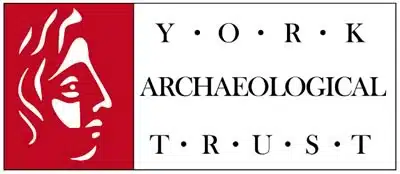
More Information
If you are looking for more to do in York, and who can blame you, why not take a look at more of Yorks attractions and events in our other York tourism and travel information guides.

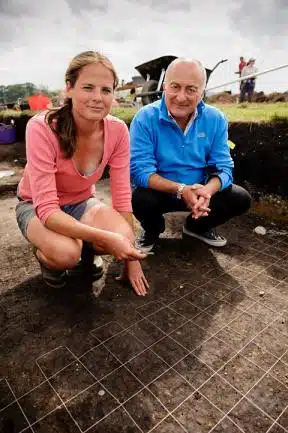 An archaeologist’s delight
An archaeologist’s delight